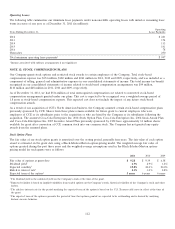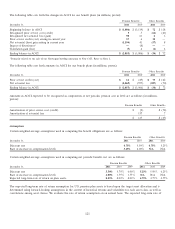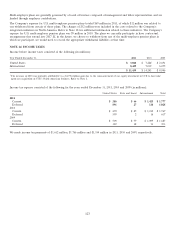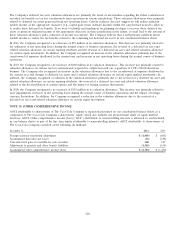Coca Cola 2011 Annual Report Download - page 124
Download and view the complete annual report
Please find page 124 of the 2011 Coca Cola annual report below. You can navigate through the pages in the report by either clicking on the pages listed below, or by using the keyword search tool below to find specific information within the annual report.
return assumption used in computing 2011 net periodic pension cost for the U.S. plans was 8.5 percent. As of December 31, 2011,
the 10-year annualized return on plan assets in the primary U.S. plan was 6.0 percent, the 15-year annualized return was
6.4 percent, and the annualized return since inception was 10.9 percent.
The assumed health care cost trend rates are as follows:
December 31, 2011 2010
Health care cost trend rate assumed for next year 8.00% 8.50%
Rate to which the cost trend rate is assumed to decline (the ultimate trend rate) 5.00% 5.00%
Year that the rate reaches the ultimate trend rate 2018 2018
The Company’s U.S. postretirement benefit plans are primarily defined dollar benefit plans that limit the effects of medical
inflation because the plans have established dollar limits for determining our contributions. As a result, the effect of a
1 percentage point change in the assumed health care cost trend rate would not be significant to the Company.
The discount rate assumptions used to account for pension and other postretirement benefit plans reflect the rates at which the
benefit obligations could be effectively settled. Rates for each of our U.S. plans at December 31, 2011, were determined using a
cash flow matching technique whereby the rates of a yield curve, developed from high-quality debt securities, were applied to the
benefit obligations to determine the appropriate discount rate. For our non-U.S. plans, we base the discount rate on comparable
indices within each of the countries. The rate of compensation increase assumption is determined by the Company based upon
annual reviews. We review external data and our own historical trends for health care costs to determine the health care cost
trend rate assumptions.
Cash Flows
Our estimated future benefit payments for funded and unfunded plans are as follows (in millions):
Year Ended December 31, 2012 2013 2014 2015 2016 2017–2021
Pension benefit payments $ 486 $ 501 $ 521 $ 537 $ 553 $ 3,042
Other benefit payments153 56 59 62 65 342
Total estimated benefit payments $ 539 $ 557 $ 580 $ 599 $ 618 $ 3,384
1The expected benefit payments for our other postretirement benefit plans are net of estimated federal subsidies expected to be received under the
Medicare Prescription Drug, Improvement and Modernization Act of 2003. Federal subsidies are estimated to be approximately $17 million for the
period 2012–2016, and $21 million for the period 2017–2021.
On March 23, 2010, the Patient Protection and Affordable Care Act (HR 3590) (the ‘‘Act’’) was signed into law. As a result of
this legislation, entities are no longer eligible to receive a tax deduction for the portion of prescription drug expenses reimbursed
under the Medicare Part D subsidy. This change resulted in a reduction of our deferred tax assets and a corresponding charge to
income tax expense of $14 million during the first quarter of 2010.
The Company anticipates making contributions in 2012 of approximately $953 million, most of which will be allocated to our
primary U.S. pension plans. The majority of these contributions are discretionary.
Defined Contribution Plans
Our Company sponsors qualified defined contribution plans covering substantially all U.S. employees. Under the primary U.S.
defined contribution plans, we match participants’ contributions up to a maximum of 3.0 percent to 3.5 percent of compensation,
subject to certain limitations. Company costs related to the U.S. plans were $78 million, $44 million and $27 million in 2011, 2010
and 2009, respectively. We also sponsor defined contribution plans in certain locations outside the United States. Company costs
associated with those plans were $31 million, $35 million and $36 million in 2011, 2010 and 2009, respectively.
Multi-Employer Plans
As a result of our acquisition of CCE’s North American business during the fourth quarter of 2010, the Company now participates
in various multi-employer pension plans in the United States. Multi-employer pension plans are designed to cover employees from
multiple employers and are typically established under collective bargaining agreements. These plans allow multiple employers to
pool their pension resources and realize efficiencies associated with the daily administration of the plan.
122
























